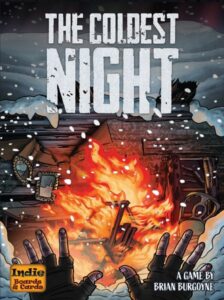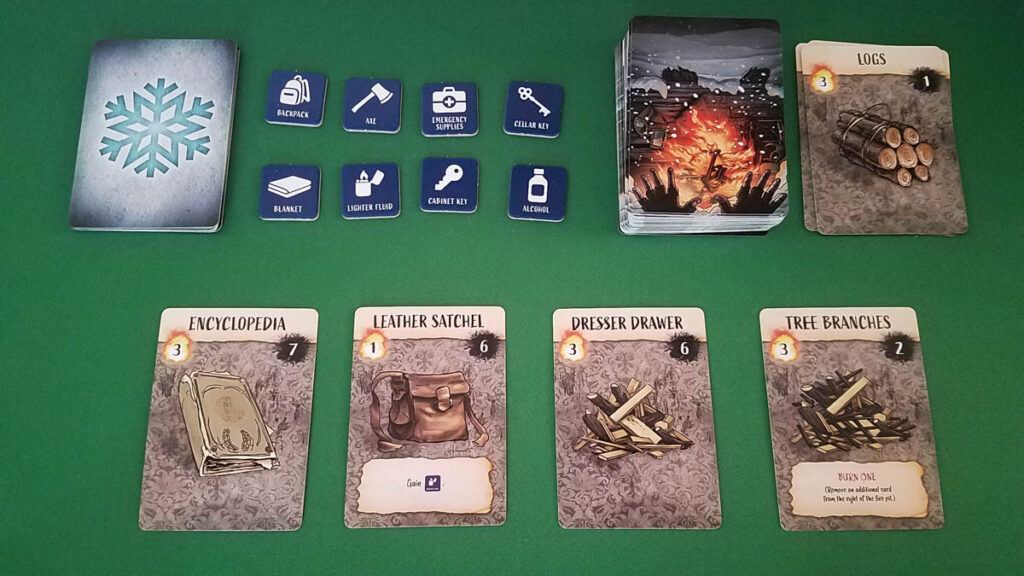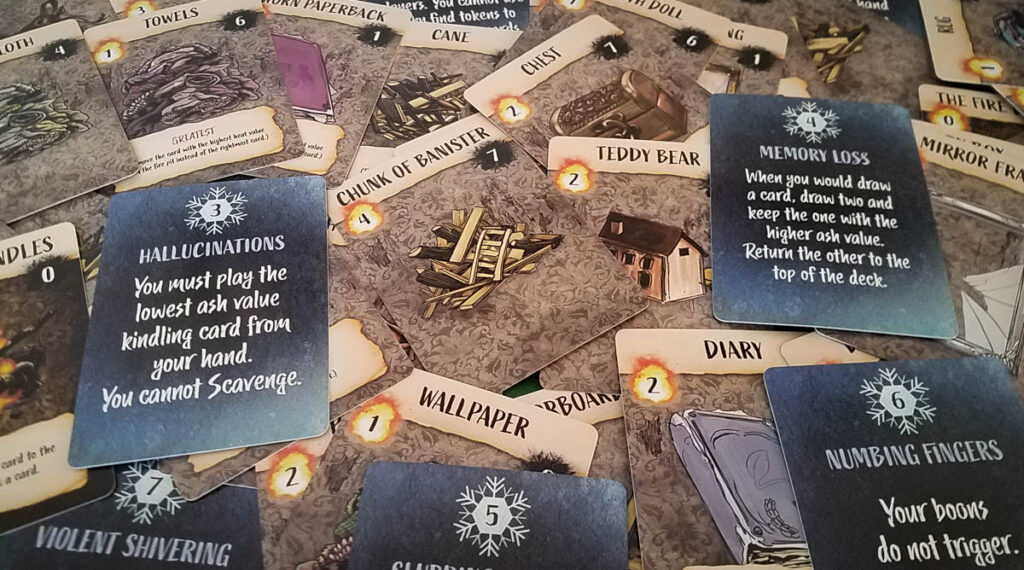The Coldest Night Review
Year: 2020 | Players: 1-4 | Minutes: 20 | Ages: 14+
This The Coldest Night review was made after playing the game about 10 times times. We were sent a copy of this game by the publisher in exchange for an honest review.
What is The Coldest Night?
The Coldest Night is a cooperative survival game in which you’re attempting to stay alive by using what you can find to keep your fire lit. The game was designed by Brian Burgoyne and is published by Indie Boards & Cards.
Rules Overview
Your job in The Coldest Night is to cooperatively play Kindling cards into the fire pit array so the fire keeps on burning. The problem is that you don’t always have the ideal cards, so you have to find ways to maintain the fire without getting too much frostbite.
Each Kindling card in The Coldest Night has a heat value and an ash value. When you play a card, it is placed to the left of the other cards in the fire pit and it has to have an ash value that is equal to or less than the total heat value of the other cards. You can play multiple cards in a turn, but there can never be more than four cards in the fire pit. If you can’t or don’t want to play a card, your only other option is to scavenge, which allows you to draw three more Kindling cards and give each card to yourself or anyone else on your team.
There are communication restrictions in this game. You can’t talk about the exact values of the cards in your hand, but you can say whether or not you’re going to need the fire to be hotter.
After you’ve played a card or scavenged, the oldest Kindling card (the rightmost card in the fire pit) gets discarded and you check for frostbite. If there are less than three cards in the fire pit, you’ll draw a Frostbite card that will give you some type of restriction until it’s removed/healed; it’s removed if the total heat value of the cards in the pit is exactly equal to the number on the Frostbite card at the beginning of a future turn. You then draw one new Kindling card and the next player takes their turn.
Some Kindling cards have special effects. The Boon cards can allow you to gain new ability tokens or give you more options when you’re removing cards from the fire pit at the end of your turn. The Obstacle cards can force you to remove the best cards from the fire pit or remove multiple cards at the end of your turn. There are also three The Fire Dwindles cards in the deck that are immediately played to the fire pit when they’re drawn and add no heat to the fire (they definitely slow you down).
You’ll win the game if you play every Kindling card to the fire pit. You’ll lose if the fire pit ever has zero cards in it or if you need to draw a Frostbite card and there are none left in the deck.
Pros and Cons
Pros
- The Coldest Night has depth that isn’t obvious right away. You might have a card in your hand that can give the fire plenty of heat, but you’ll learn that sometimes it’s best to hold on to those types of cards for when you are more desperate for that extra heat. You also have to play those terrible Obstacle cards at some point to win, so timing is key with every type of card.
- The survival theme is well implemented and it’s just a great theme for a co-op. The tension is definitely there and it doesn’t take much effort to feel like you’re a group of people desperate to stay warm in insanely cold conditions. Scavenging, for example, is a very thematic mechanism because it just makes sense that you’d have to go find more stuff to burn at the risk of getting frostbite. It’s actually pretty hard to find a light card game like this that has a theme that really shines.
- This is one of those “satisfyingly tough” co-op games. You might lose badly, but you’ll probably want to jump right back in and try again.
- I like how the Frostbite cards work. There’s a good mix of negative effects and they do change up how the games play out.
- I think the cards look great. Every image pops.
- The Coldest Night is a consistently 20 minute game, so it works really well as a filler game.
- Setup is extremely quick, as is teardown.
- Great game title.
Cons
- Every game of The Coldest Night is going to play out a bit differently since the cards will come out in a different order, but after four or five games it does start to feel a bit samey. I think that’s because the deck always has the exact same cards in it, so the surprise factor goes away pretty quickly. That gives the game less replay value, but I don’t have a huge problem with that since it is a filler game.
- I’m not a fan of these limited communication rules. To me, it would make more sense thematically if you could at least say the names of the cards in your hand. It just feels like a forced rule to make the game slightly tougher and to get around the quarterbacking/alpha player issue.
Final Thoughts
The Coldest Night hasn’t been a big hit with my group, but everyone I’ve played it with so far has enjoyed it. The theme is great, it’s challenging, and it has a different feel to it when compared to other cooperative hand management games. It doesn’t have great replay value, but I’m still going to keep it on my shelf since I think it works well as a filler game and I can teach it to just about anyone.
As a co-op, I think The Coldest Night works best as a two-player card game, but I also thought it played well at three (I haven’t tried four-player yet). Its solo variant is arguably the best way to play the game, though, since you have a bit more control over your cards and you randomly remove some cards from the deck each game.
If you like light cooperative games and this survival theme seems interesting to you, chances are you’ll be a fan of The Coldest Night.
The Coldest Night Links
BGG | Amazon | Game Nerdz
Thanks for taking the time to read our The Coldest Night review!
Be sure to take a look at our favorite top cooperative board games for more great game ideas!
To stay updated on all things cooperative board games, follow us on Twitter, Facebook, or via RSS.



